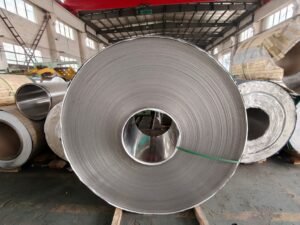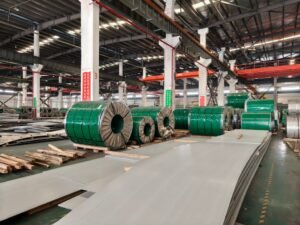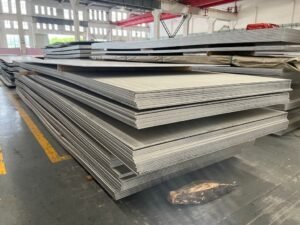Introduction
Choosing the wrong beam can sink a project’s budget or compromise structural safety. Engineers and builders face this dilemma daily when weighing H-Beam vs. I-Beam options, where strength, cost, and design flexibility hang in the balance.
H-beams offer unmatched stability for massive builds, while I-beams shine in lighter frameworks, saving material without sacrificing performance. This guide breaks down their key differences, load capacities, and best uses to help you pick the no-brainer beam for your next project.
What Are H-Beams and I-Beams?
Understanding the differences between H-beams and I-beams is key to picking the right structural support for your construction project. Both beams are vital in building sturdy frameworks, but their unique designs suit different needs. Let’s break down their shapes, uses, and why they matter in construction.
Defining H-Beams: Shape, Flange Width, and Structural Role
H-beams have a wide flange that gives them a strong, boxy look. Their shape makes them awesome at handling heavy loads, which is why they’re often used in big projects like skyscrapers or bridges. HnL Steel, for example, crafts H-beams with precision, ensuring they meet tough project specs.
The wider flanges boost H-beam advantages, like better resistance to bending under pressure. This design spreads weight evenly, making them a go-to choice for massive structures. Plus, they can be customized for specific jobs, saving time and money in the long run.
Defining I-Beams: Narrower Flanges and Design Basics
I-beams, on the other hand, have narrower flanges, giving them a more slender profile. They’re lighter than H-beams, which makes them easier to handle for smaller projects like residential buildings. I-beam properties shine when you need solid support without extra bulk.
Despite their slimmer build, I-beams are still tough and cost-effective. They’re perfect for projects where weight and budget are concerns. HnL Steel offers I-beams tailored to various standards, ensuring quality without breaking the bank.
The main difference between H-beams and I-beams lies in their flange width and load-bearing capacity, impacting their use in construction projects.
Historical Context and Evolution in Construction
Beams have been around since the early days of steel construction in the 19th century. Back then, I-beams were the star, used in everything from railroads to early skyscrapers. Over time, engineers realized wider flanges could handle more stress, leading to the rise of H-beams.
Today, the H-beam vs. I-beam debate depends on project scale. H-beams dominate large-scale builds due to their strength, while I-beams remain popular for lighter jobs. This evolution shows how design tweaks can make a big impact.
Common Materials Used in Beam Fabrication
Most H-beams and I-beams are made from steel, thanks to its strength and durability. Stainless steel and galvanized options resist rust, which is great for outdoor projects. Some beams even mix in alloys to boost specific traits like flexibility or corrosion resistance.
HnL Steel sources high-quality materials, ensuring beams meet global standards like ASTM or JIS. Their focus on quality means you get beams that last, whether for a warehouse or a coastal bridge. The right material choice can make or break a project’s success.
Beam Comparison Table
| Feature | H-Beam | I-Beam | Material Standard | Typical Use |
|---|---|---|---|---|
| Flange Width | Wide (equal to web) | Narrower | ASTM A992 | Skyscrapers vs. Homes |
| Weight (kg/m) | 50-100 | 20-60 | EN 10025 | Bridges vs. Warehouses |
| Load Capacity | High (500 kN) | Moderate (300 kN) | JIS G3101 | Heavy vs. Light Duty |
| Cost ($/ton) | 800-1000 | 600-800 | GB/T 11263 | Large vs. Small Projects |
| Corrosion Resistance | Galvanized Option | Galvanized Option | ISO 1461 | Outdoor vs. Indoor |
Note: Load capacity measured under standard deflection tests; costs vary by region and supplier.
Choosing between an H-beam vs. I-beam depends on your project’s needs. H-beams may cost more upfront, but their strength can save cash over time on big builds. I-beams, meanwhile, keep things affordable for smaller jobs without skimping on reliability.

Structural and Load-Bearing Differences
When choosing between H-beams and I-beams, understanding their structural and load-bearing differences is crucial for smart engineering decisions. The H-beam vs. I-beam debate hinges on how each handles forces and supports structures. Let’s dive into the technical details to guide your next project.
Flange and Web Design: How H-Beams Handle Multidirectional Loads
H-beams have wide flanges and a thick web, making them champs at handling multidirectional loads. This design spreads stress evenly, perfect for complex structures like bridges or high-rises. HnL Steel’s H-beams are built to take on heavy-duty tasks without buckling.
The broader flange gives H-beams an edge in resisting twisting forces. Engineers love them for projects needing stability under varied pressures. Their strength makes them a rock-solid choice for big builds.
I-Beam Efficiency for Unidirectional Forces
I-beams, with narrower flanges, are designed for unidirectional forces, like supporting a floor in a house. Their I-beam load capacity shines in simpler setups where weight pushes straight down. They’re lighter, so handling and installation are a breeze.
While not as versatile as H-beams, I-beams are cost-effective for smaller projects. HnL Steel delivers I-beams fast, ensuring you stay on schedule. This efficiency keeps budgets tight without sacrificing quality.
In a structural beam comparison, H-beams excel with multidirectional loads, while I-beams are ideal for unidirectional forces, impacting project design choices.
Load-Bearing Capacity Comparison Across Scenarios
H-beams can carry heavier loads—think 500 kN in large spans—thanks to their robust design. I-beams handle around 300 kN, better suited for shorter spans or lighter structures. The H-beam vs. I-beam structural comparison shows H-beams winning for massive projects.
For example, a skyscraper needs H-beams to support its weight and wind forces. I-beams work great for a warehouse with consistent, downward loads. HnL Steel’s bulk orders ensure you get the right beam for any scenario.
Impact of Beam Shape on Structural Stability
Beam shape directly affects stability. H-beams’ wider flanges reduce deflection, keeping structures steady under stress. I-beams, though less stable under lateral forces, hold up well in straightforward designs.
The H-beam vs. I-beam choice can make or break a project’s safety. HnL Steel’s custom fabrication means you get beams tailored for stability, cutting delays. This precision boosts long-term performance, especially in tough conditions.
Load-Bearing Comparison Table
| Scenario | H-Beam Capacity (kN) | I-Beam Capacity (kN) | Stability Factor | Use Case |
|---|---|---|---|---|
| Short Span (10m) | 400 | 250 | High vs. Moderate | Warehouse vs. Home |
| Long Span (20m) | 500 | 300 | High vs. Low | Bridge vs. Shed |
| Wind Load | 450 | 200 | Strong vs. Weak | Skyscraper vs. Barn |
| Dynamic Load | 420 | 220 | Stable vs. Limited | Factory vs. Deck |
| Seismic Load | 480 | 280 | Robust vs. Fair | Tower vs. Garage |
Note: Capacity tested under ASTM standards; stability factor reflects deflection resistance.
While H-beams cost more upfront, their strength saves money over time on large projects. I-beams keep things affordable for simpler builds. With HnL Steel’s fast delivery, your H-beam vs. I-beam choice lands on time, every time.
Span Capabilities and Design Flexibility
Choosing between H-beams and I-beams for your construction project often comes down to span capabilities and design flexibility. The H-beam vs. I-beam comparison reveals distinct strengths that shape open-space designs and project outcomes. Let’s explore how these structural steel types support architectural goals.
H-Beams for Long Spans: Up to 330 Feet Without Columns
H-beams are built for epic spans, reaching up to 330 feet without needing columns. Their wide flanges and sturdy webs handle massive loads, making H-beam applications ideal for sprawling structures like airports or arenas. HnL Steel’s custom-cut H-beams ensure these spans stay strong and reliable.
This capability lets architects dream big, creating vast, uninterrupted spaces. Despite higher upfront costs, H-beams save money long-term by reducing the need for extra supports. Their strength makes them a “no-brainer” for large-scale projects.
I-Beam Limitations: Typical 33-100 Feet Range
I-beams typically span 33 to 100 feet, perfect for smaller or medium-sized buildings like offices or homes. Their narrower flanges mean less weight, which simplifies installation but limits their reach. I-beams shine in projects where shorter spans keep costs low.
HnL Steel crafts I-beams to fit precise specs, ensuring they perform well within their range. While not suited for huge spans, their affordability makes them a go-to for practical designs. This balance keeps I-beams relevant in countless builds.
H-beams support spans up to 330 feet for open designs, while I-beams work best for 33-100 feet, guiding project scale decisions.
Design Implications for Open-Floor Plans
Open-floor plans thrive with the right beam choice. H-beams allow for column-free spaces, giving architects freedom to design airy, flexible layouts. The H-beam vs. I-beam choice here leans toward H-beams for bigger, bolder visions.
I-beams, though, fit snugly into tighter designs, supporting open floors in smaller settings. HnL Steel’s fast delivery means your beams arrive ready to shape these spaces. Picking the right beam aligns structure with style.
Role of Beam Choice in Aesthetic and Functional Outcomes
Beams do more than hold things up—they impact a building’s look and feel. H-beams, with their robust profile, often stay hidden in large projects to keep aesthetics clean. I-beams, being slimmer, can sometimes be left exposed for an industrial vibe.
Functionally, H-beams boost stability for dynamic loads, while I-beams keep things simple and cost-effective. HnL Steel’s tailored beams ensure both beauty and strength, meeting best practices for choosing beams in construction.
Span Capability Comparison Table
| Feature | H-Beam | I-Beam | Design Impact | Standard |
|---|---|---|---|---|
| Max Span (ft) | 330 | 100 | Open vs. Compact | ASTM A992 |
| Column Need | None | 1-2 | Free vs. Restricted | EN 10025 |
| Load Support (kN) | 500 | 300 | Heavy vs. Light | JIS G3101 |
| Cost ($/ft) | 50-70 | 30-50 | Premium vs. Budget | GB/T 11263 |
| Aesthetic Fit | Hidden | Exposed Option | Modern vs. Industrial | ISO 1461 |
Note: Span data based on standard load tests; costs vary by market.
Whether chasing vast spans or cozy layouts, H-beams and I-beams offer unique perks. HnL Steel’s custom options make sure your vision comes to life without delays. Choose wisely to nail both function and flair.
Cost, Material Efficiency, and Sustainability
Balancing cost, material efficiency, and sustainability is key when choosing between H-beams and I-beams. The H-beam vs. I-beam comparison reveals trade-offs that impact budgets and environmental goals. Let’s dive into how these beams stack up for smart project planning.
H-Beam Costs: Higher Upfront, Lower Maintenance
H-beams come with a steeper price tag, often $800-$1000 per ton, due to their robust design. Yet, H-beam advantages include lower maintenance costs over time, thanks to their durability under heavy loads. For large projects, this can mean big savings down the road.
HnL Steel’s flexible payment terms make these costs easier to manage. Their custom H-beams are built to last, reducing repairs and replacements. This durability makes them a bang-for-your-buck choice for long-term builds.
I-Beam Affordability: Material Savings for Smaller Projects
I-beams are more budget-friendly, typically costing $600-$800 per ton. Their slimmer I-beam properties use less steel, cutting material expenses for smaller projects like homes or warehouses. This affordability appeals to cost-conscious builders.
HnL Steel ensures I-beams meet high standards while keeping prices competitive. Their fast delivery minimizes delays, saving you money on labor. For smaller-scale jobs, I-beams deliver solid value without skimping on strength.
H-beams cost more upfront but save on maintenance, while I-beams offer material savings, ideal for smaller budgets and projects.
Steel Usage and Environmental Footprint
H-beams require more steel—about 50-100 kg/m—compared to I-beams at 20-60 kg/m. This higher material use increases their environmental footprint during production. However, their longevity reduces waste over time.
I-beams, using less steel, have a smaller initial impact. HnL Steel sources sustainably, with options like galvanized beams to boost durability and recyclability. Choosing the right beam balances eco-goals with project needs.
Lifecycle Cost Analysis for Budget Planning
Lifecycle costs tell the full story. H-beams, despite higher initial costs, often save money over decades due to their strength and low upkeep. The differences between H-beam and I-beam shine in large projects where durability cuts long-term expenses.
I-beams keep upfront costs low but may need more frequent maintenance in demanding settings. HnL Steel’s expertise helps you plan budgets with beams tailored for efficiency. Their sustainable practices add value for eco-minded builders.
Cost and Efficiency Comparison Table
| Metric | H-Beam | I-Beam | Environmental Impact | Lifecycle Cost |
|---|---|---|---|---|
| Cost ($/ton) | 800-1000 | 600-800 | Moderate vs. Low | Lower Long-Term |
| Steel Usage (kg/m) | 50-100 | 20-60 | Higher vs. Lower | Stable vs. Variable |
| Maintenance (yrs) | 20-30 | 10-20 | Low vs. Moderate | $500 vs. $1000 |
| Recyclability | 95% | 95% | High vs. High | Cost-Neutral |
| CO2 Emissions (kg/ton) | 2000 | 1500 | Higher vs. Lower | Offset by Durability |
Note: Emissions based on standard steel production; maintenance costs estimated over 30 years.
The H-beam vs. I-beam choice hinges on your priorities—long-term savings or upfront affordability. HnL Steel’s sustainable sourcing and payment flexibility make either option a win for cost and eco-conscious builders. Plan wisely to hit both budget and green goals.

Choosing the Right Beam for Your Project
Selecting the right beam for your construction project can make or break its success. The H-beam vs. I-beam decision depends on your project’s scale, load needs, and budget. Let’s walk through a clear framework to pick the best beam, ensuring efficiency and strength.
Project Scale and Load Requirements Checklist
Start by assessing your project’s size and load demands. For heavy loads or long spans, H-beams shine in a structural beam comparison due to their ability to handle up to 500 kN. I-beams suit lighter loads, around 300 kN, for smaller builds.
Create a checklist: span length, load type (static or dynamic), and environmental factors like wind or seismic activity. HnL Steel’s consultation services help you nail this step, offering tailored advice for best practices for choosing beams in construction.
When to Choose H-Beams: Large-Scale Structures
H-beams are your go-to for big projects like bridges or skyscrapers. Their wide flanges and robust design make H-beam applications perfect for spans up to 330 feet without columns. Despite higher costs, they save money long-term by cutting maintenance.
HnL Steel crafts custom H-beams to match exact specs, ensuring no overpaying for unused strength. Their expertise means you get beams that handle complex loads like a boss. Large-scale builds thrive with this durability.
For large projects, H-beams support vast spans and heavy loads, while I-beams fit smaller builds, guiding your beam choice.
When to Choose I-Beams: Residential and Light Commercial
I-beams are ideal for homes, offices, or light commercial spaces with spans of 33-100 feet. They’re lighter and cheaper, keeping budgets in check without sacrificing reliability. Their slimmer design simplifies installation for smaller crews.
In a H-beam vs. I-beam matchup, I-beams win for cost-conscious projects. HnL Steel’s fast delivery ensures these beams arrive ready to perform. They’re a practical pick when strength needs are moderate.
Consulting Structural Engineers and Suppliers for Precision
Don’t go it alone—consult experts to avoid costly mistakes. Structural engineers analyze load paths and conditions, while suppliers like HnL Steel offer insights on beam fit. Their custom fabrication ensures beams match your vision perfectly.
The H-beam vs. I-beam choice benefits from this teamwork. HnL Steel’s pros guide you through material options and standards like ASTM or JIS. This precision keeps projects on track and within budget.
Beam Selection Guide Table
| Factor | H-Beam | I-Beam | Best Fit | Standard |
|---|---|---|---|---|
| Span (ft) | Up to 330 | 33-100 | Large vs. Small | ASTM A992 |
| Load (kN) | 500 | 300 | Heavy vs. Light | EN 10025 |
| Cost ($/ton) | 800-1000 | 600-800 | Premium vs. Budget | JIS G3101 |
| Maintenance | Low | Moderate | Long vs. Short Term | GB/T 11263 |
| Use Case | Bridge | Home | Complex vs. Simple | ISO 1461 |
Note: Load data from standard tests; costs vary by region.
Choosing between H-beams and I-beams means weighing scale, cost, and durability. HnL Steel’s custom solutions and expert advice make the process smooth, delivering beams that fit your goals. Follow this guide to build strong and smart.
Conclusion
After years in the steel game, I’ve seen how picking the right beam shapes a project’s success. H-beams bring the muscle for massive builds like bridges, while I-beams keep things lean and affordable for homes or smaller setups.
Choosing between them isn’t just about specs—it’s about nailing the balance of strength, cost, and vision. With HnL Steel’s custom options, you get beams that fit your needs like a glove, backed by quality you can trust.
Your next build deserves the right foundation. Think about your project’s scale and goals—whether it’s a skyscraper or a cozy office, picking the right fit beam sets you up to win.
FAQ
Q1: What are the main differences between H-Beam and I-Beam?
A1: The main differences between H-beams and I-beams lie in their design and strength. H-beams have wider flanges and a thicker web, providing better load-bearing capacity and stability, ideal for large structures, while I-beams have a narrower profile suitable for smaller projects.
Q2: Which beam can support larger spans, H-Beam or I-Beam?
A2: H-beams can support spans of up to 330 feet, making them suitable for large constructions like bridges, whereas I-beams are typically limited to spans of 33 to 100 feet.
Q3: Are H-Beams more expensive than I-Beams?
A3: Generally, H-beams are more expensive due to their manufacturing complexity and ability to support heavier loads, which makes them preferable for larger structures.
Q4: What applications are suitable for H-Beams?
A4: H-beams are commonly used in large-scale projects where high strength and load capacity are required, such as skyscrapers, bridges, and industrial buildings.
Q5: What is the load capacity comparison between H-Beam and I-Beam?
A5: H-beams typically have a higher load capacity than I-beams due to their wider flanges and thicker web, making them suitable for heavier loads.
Q6: Can I use I-Beams in large construction projects?
A6: While I-beams can be used in some larger projects, they are better suited for lighter loads and smaller spans compared to H-beams, which are designed for high-strength applications.
Q7: How do the designs of H-Beams and I-Beams impact flexibility in construction?
A7: The design of H-beams offers greater stability and load distribution, making them more flexible for various construction designs, whereas I-beams are less flexible due to their narrower profile.
Q8: What is a typical weight comparison between H-Beams and I-Beams?
A8: H-beams are generally heavier than I-beams due to their larger cross-section, which contributes to their increased strength and load-bearing capacity.
External Links
- H-Beams vs I-Beams: Understanding the Key Differences
- H-Beam vs I-Beam: Understanding Key Differences and Applications
- I-Beam vs. H-Beam: Which Steel Beam is Best for Your Project?
- H beam vs I beam: Difference and Comparison
- Difference Between Steel I-Beam and H-Beam
- Difference Between H Beam and I Beam – HPD CONSULT
- I-Beam vs H-Beam: What Is the Difference?
- H-Beam vs I-Beam | Difference Between H-Beam and I-Beam – Tampa Steel






One Response